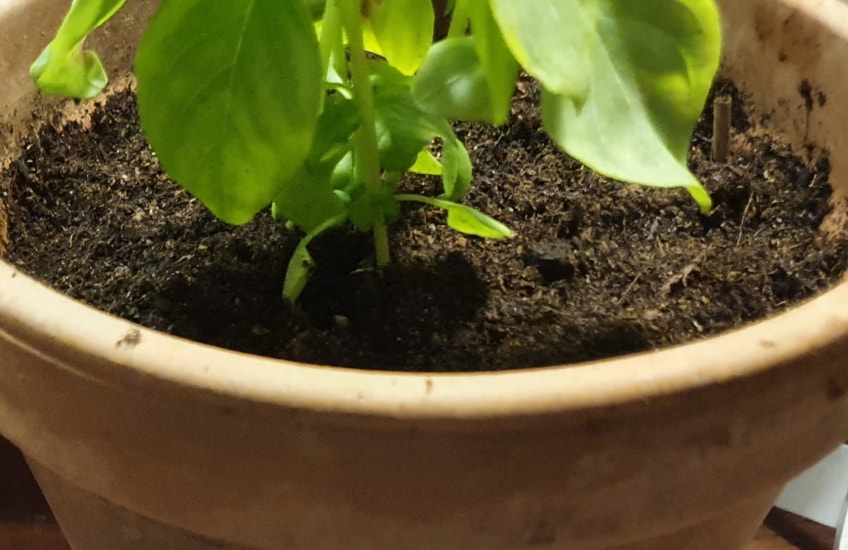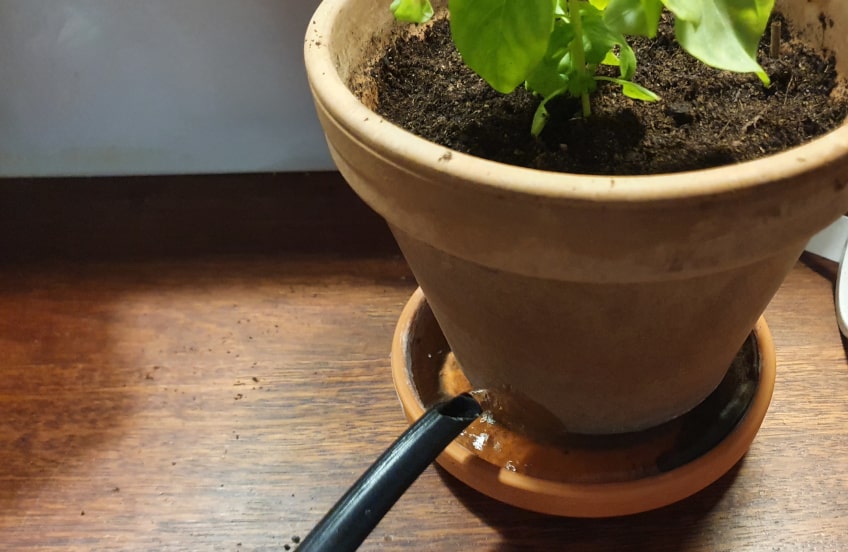At one point, I noticed that some mold had started appearing on the top of the soil one of my basil plants was growing in, so to save the plant, I had to find out what exactly to do about it. What I learned saved my plant, so I thought I would write this post to help anybody with the same issue.
If there is mold on the top of your basil’s soil, remove it or transplant the basil to another pot. In most cases, the mold can be scraped off easily with a spoon or knife, but if there is a lot of it, the safest thing to do to save the plant is to move it to another pot.
In this post, I cover what to do when mold begins to appear on top of the soil your basil is growing in, and then I describe how you can prevent it from happening again.

What to Do About Mold on Soil Where Basil is Growing
To begin, it is important to say that mold on top of the soil you are growing plants in usually isn’t a big problem and can be taken care of easily, so don’t worry.
What you have to do about it depends on a few things. It’s mostly how much mold there is, what kind of pot or container your basil is growing in, and how much water it is getting.
If there is a small amount of mold on the soil your basil is growing in, the mold can usually be removed easily using a spoon, a knife, or something similar. However, if it covers the entire top of the soil, the best way to save the plant is to transplant it and move it to a different pot with fresh soil.
I use and highly recommend terra cotta pots like these from Amazon if you need to transplant your basil.
The most important thing you can do to avoid getting mold on your basil’s soil in the future is to know how to water it correctly. I cover everything you should know about that in the article on this link.
Now I will first explain what you should do if there is only a little mold on the soil your basil plant is growing in and then what to do if there is a lot. Pick the one that applies to you.
Here is what you should do if there is only a little bit of mold on the soil:
- The first thing you should do when you notice mold on top of the soil, is to see if the plant itself is affected. This is usually not the case, but if it is, remove any part of the plant that is affected.
- Use a spoon, a knife or similar to gently scrape off the mold without damaging the plant.
- Place the pot with the plant in a spot where it receives plenty of sunlight and the air can flow freely.
- Allow the top of the soil to dry out. Once it is dry, water the plant in small doses once per day whenever the top of the soil is dry.
- Check back every day for a week to see if the mold reappears.
If this does not work for your plant or there is too much mold on the soil, it is time to take more drastic measures. However, there is still no need to worry as long as the plant itself still looks fine.
If there is a lot of mold on the soil or it keeps coming back after scraping it off, do this:
- Prepare to transplant the basil to another pot by getting a new pot, fresh soil, and water.
- Gently remove the basil plant from its current pot by pulling lightly at the base of the stems until the plant lets go of the pot.
- Remove as much soil from the roots as possible without damaging the roots.
- Fill the new pot about one third of the way with soil.
- Gently untangle some of the roots from your basil plant and spread them around the soil in the pot while still holding the plant itself a few inches above the soil.
- Hold your basil plant at the level you want it to be at while gently filling the pot with soil untill all the roots are covered and the plant staple.
- Place the pot where the plant gets full sun and good airflow.
- Water the plant well right after it has been transplanted.
- Water the plant in small doses whenever the top of the soil is dry.
If you need help choosing the right pot to transplant your basil into, I have a guide for you here.
When transplanting a plant to a new pot, it is usually a good idea to leave as much soil on the roots as possible to make the transition easier on the plant, but since the issue here is that there is a lot of mold on (and perhaps in) the soil, it is better to remove as much as possible.
The transition may be a bit rough for your basil plant, but it is still much better than leaving it in moldy soil.
Enough sun (but not too much) and proper watering are key to caring for basil and preventing mold, so I recommend you head over to this post, where I cover exactly how to care for basil plants when it comes to sunlight watering, temperature, fertilizing, and pruning.
How to Prevent Getting Mold on the Soil

The easiest and most effective way to deal with mold on the top of the soil is to prevent it before it even appears. I have a couple of good tricks for this to share with you.
- Use a pot or container with drainage holes.
Drainage holes allow the water to run through the pot rather than stay. This is important to prevent overwatering, root rot, and mold. I like to use terra cotta pots with a drainage hole at the bottom such as these from Amazon. The material allows moisture to escape through the sides of the pot and the drainage hole is important for getting rid of excess water. The combination is an excellent way to reduce the risk of mold and other problems.
- Water more frequently but in smaller doses.
Basil plants grow best in soil that is consistently moist and never completely dry or wet.
- Always water basil from the bottom.
Instead of pouring water onto the top of the soil, pour it into the plate underneath the pot like in the photo above. Doing that not only reduces the risk of mold on the top of the soil but also promotes root growth which leads to healthier plants. Read more about that on this link.
- Remove excess water from the plate.
If the plate underneath the pot still has water in it 20 minutes after you poured water in it, remove it. If the soil has not absorbed the water by then, the soil and roots already have all the water they need.
- Clean the pot that had mold in it thoroughly.
It is important that you clean the pot that had mold in it thoroughly before using it again. Otherwise, the mold may come back.
Why Does Your Basil Plant Suddenly Have Mold on the Soil?
Mold on top of the soil in a pot is most often the result of too much humidity and too little airflow.
If a basil plant has been getting more water than it can use for too long, it will begin to show signs of overwatering. I have written another post to help you find out if your basil plant has been overwatered.
In my experience, the best pots for growing herbs and most other plants are terracotta pots. This is because they usually have excellent drainage, and the material the pots are made from allows the soil to breathe much better than many other types of pots.
If there are no drainage holes in the pot, it can be challenging to water the plant properly since too much water will damage it. With drainage holes, excess water will run through the soil instead of staying inside and causing damage.
Airflow is another crucial factor when growing basil. Air sitting still and not moving increases the risk of mold, so place your basil plant in a spot with good airflow and full sun for at least 6 hours per day.
Read My Complete Guide to Growing and Caring for Basil
I have written a thorough guide where I cover all parts of growing your own basil including choosing a variety, sowing the seeds, the best growing conditions, pruning, propagation, harvesting, storing, solving various problems, and a lot more. You can find the article on this link.

